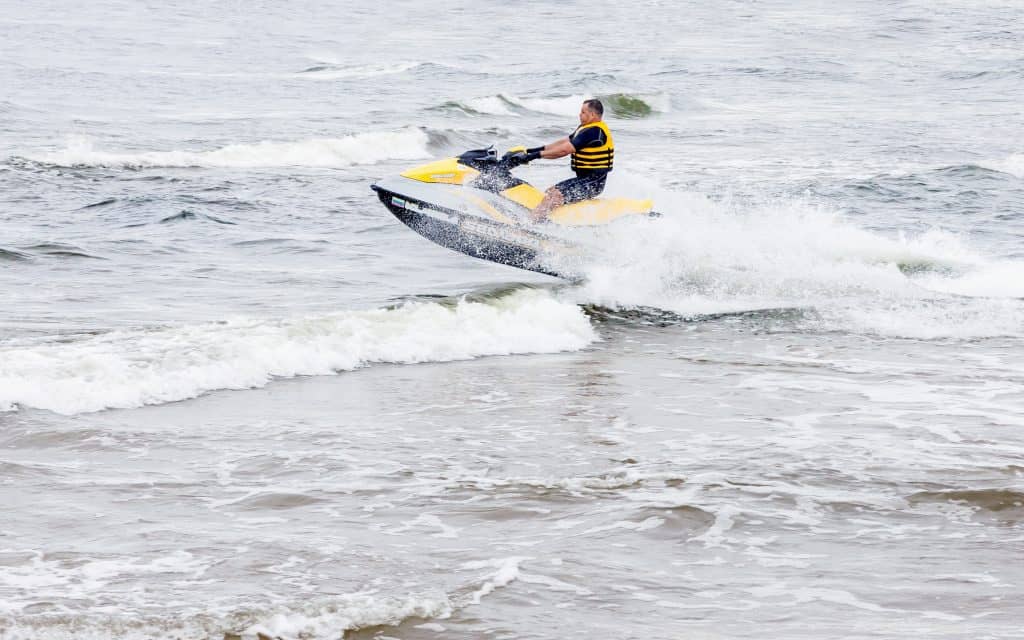When doing something as exciting as jet skiing, it can be easy to lose track of time. That is not the only thing that you can lose track of, though. It can be hard to focus on anything besides the control of your jet ski and the surface of the water when you are gliding along at high speeds.
Unless you miss a big and important meeting, spending an hour or two more on the water than you originally planned is not a big deal. There are, however, other things that are more dangerous to lose track of.
In many areas, the weather can take a turn for the worse in a matter of minutes. One moment the sun could be shining brightly, and the next there could be strong winds bringing in dark clouds with lightning and hail ready to be released.
So, what should you do if you find yourself out on the water when conditions get rough? In this article, we’ll take a look at a few things to do to reduce the risk of being caught in rough water as well as what to do when there is no avoiding it.
Always Plan Ahead When Jet Skiing
I like hiking and I do it as often as I can. I have asked people more experienced than myself what to do if I encounter a bear, and they usually start by saying something along the lines of “The only bear encounter you have a 100% chance of surviving is one that does not happen.”
While this advice might seem obvious and a little silly, it really is the truth. The same goes for jet skiing in rough water. The best way to make it out unscathed is by not being in rough water in the first place. Of course, sometimes things happen which are beyond our control. But, there are things you can do to reduce the chance of that happening.
Check the Forecast
Water can become rough for a number of reasons, but the most common is probably because of inclement weather. Strong winds can create large waves and pouring rain can make it difficult to see. Most people probably would not hop on a jet ski in the middle of a storm, but they can roll in pretty quickly.
That is why it is important to check the forecast for the whole day, not only for the time you plan on riding. It also helps to be familiar with terms that are used. The National Weather Service provides classifications for the different strength levels of wind.
Starting out, winds of 0 to 15 miles per hour are described as light or varied.
Winds between 15 and 25 miles per hour are described as breezy in mild temperatures and brisk or blustery in cold temperatures.
When wind speeds are between 20 and 30 miles per hour, the term windy is used to describe conditions.
When the wind is between 30 and 40 miles per hour, conditions are described as very windy.
Finally, when wind speeds are over 40 miles per hour, the wind is said to be strong, dangerous, high, or damaging.
These terms, as well as other forecasting definitions, can be found at this website.
It is important to note that even though you hear “light wind” in the forecast, winds of 15 miles per hour can still have a fairly significant effect on the water, especially when it comes to a small vessel like a jet ski.
As a rule of thumb, if you are unsure of whether you would be able to handle your jet ski safely, it is better to play it safe and not go out.

Jet Ski Prep
Nobody can control the weather, and sometimes it ruins the day and you just have to deal with it. However, there are some things that you can control.
It is important to make sure that your jet ski is always running in top shape. If you are paying attention, it is not terribly hard to spot a storm that is still far off. In a situation like that, you should have plenty of time to get back to shore. But, what if your jet ski happens to break down just when you need to get off of the water?
Avoiding a break down is simple. As long as you take care of the jet ski by not running it too hard and taking it in for recommended servicing, there will be little to worry about on this front. Jet skis are known to be pretty reliable as long as they are not mistreated.
If you do find yourself stranded on a broken down jet ski, it is important to get help as quickly as possible. Having some kind of signal on board to indicate to others that you are in need of assistance is essential. The signal can be visual, such as a flag or a flare, or audial, such as an air horn or a loud whistle.
It goes without saying that you should always have a lifejacket on. Not only is it a good safety habit, but it is also the law.
Possibly more important than having certain items is knowing how to handle the items that you do have. What I mean by this is that people often use jet skis for activities like fishing, tubing, water skiing, and wakeboarding.
If you are in the middle of a tubing session or have two fishing lines out when you notice a storm coming in, you need to know how to gather up your things quickly, efficiently, and safely. Every minute counts when it comes to getting off of the water in time. This just takes practice on your part.
The best way not to get caught up gathering your things is, of course, to just not bring very much. On days where there is a chance of bad weather, it would be a good idea to just not bring a lot of things out with you on the jet ski.
Another item to have that can prove useful is an anchor. If the engine does stop for whatever reason, you can drop the anchor. This will help mitigate the effects of the waves and keep the jet ski more stable, even if it’s just a little.
One last piece of equipment to check and make sure it works is the bilge pump. A bilge pump helps empty water from the engine compartment. Engine compartments are made to keep water out but with crashing waves and hard rain, it is not difficult to understand that some water could get in.
An engine flood is one of the last things you would ever want on a jet ski, but that applies even more so in this kind of situation. Having a functioning bilge pump is an absolutely vital part of being prepared for rough water conditions.

Assess the Situation
Of course, it is not always possible to avoid a bad situation. If you find yourself on the water with the inclement weather rolling in faster than you can get out, it is important to remain calm. Depending on the situation, you might have more options than just jetting as quickly as you can over to the shore.
Jet skis are built to be very stable, even in rough water. Sitting still can sometimes be a better option than trying to leave. However, you will need to pay very close attention to the weather, and it helps to be familiar with storms that happen in your area.
If you are confident that the water will be calmer after a couple of minutes, you can just sit and wait for the weather to calm down so that you can navigate your wait out in safer and easier conditions.
If you are going to wait for any amount of time, make sure that your anchor is out. You should also stand up instead of sit on the seat. It might sound strange because you feel more stable while sitting, but standing can help prevent injuries.
In rough water, the jet ski is jostled about, which means that you are too. If you are sitting down on the seat, the impact of the waves gets absorbed in large part by your spine. This can cause back and neck pain or injuries. If you stand up with your knees bent, your legs will absorb the impact from the waves, and they are much better for the job than your spine.
Once again, you should only wait if you have experience and you are confident that a better opportunity to leave will present itself. If you have any suspicion at all that the water conditions will only get worse, you should go ahead and get to the shore as quickly as you can without delay.
If You Have to Go Jet Skiing, Take it Slow
If you can’t get out before things get rough and you decide that waiting would not be a good idea, then you should start heading back to shore right away. However, that does not mean driving as fast as you can.
Keep Your Speed Low and Under Control
Driving at high speeds through rough water will make for a bumpier ride, which can cause you to be thrown off or cause the jet ski to capsize. While it is understandable that you would want to get out of the water as fast as possible, going too fast might make it so that it is not possible at all.
Keep your speed low and consistent. The more you stop and start, the bumpier the ride will be and the more risk you run of losing control and going off course.

Approaching the Waves
Wave jumping is a common and fun activity to do on a jet ski. However, heading directly into the waves during a storm like you would any other time is not a good idea. The main idea of navigating through rough water is keeping steady. Taking the full force of a wave head-on will not help that cause.
When you see a large wave in front of you, the best way to pass over it is by approaching it at a 45-degree angle. That will cause the least forceful impact possible.
Be on the Lookout for Obstacles
High winds and strong waves can carry any number of things out into the open water. I once saw a pretty good-sized tree trunk out in the middle of a lake after a storm. There can be debris of all kinds out there, so it is important to avoid it so that your jet ski will not be damaged and you will not be injured.
Another obstacle to look out for is other watercraft. The reduced visibility brought on by a storm makes it harder for everyone to see, so it is important to be extra vigilant. A collision with another boat would likely be much worse than running over a branch or a stray water toy.
This is where something like an air horn would come in handy. Making yourself as noticeable as possible is the key to avoiding collisions.
This video provides an excellent example of how to drive through rough water. Although they are in a boat, the same principles apply to jet skis.
Most Importantly, Stay Calm!
The worst thing that anyone can do in an emergency situation is panic. Unfortunately, that is often the first thing that people are prone to do. It can be incredibly difficult to keep cool under that pressure.
It is understandable, of course. The stakes are high and making a mistake in this type of situation can mean getting hurt or worse.
The best way to stay in control of yourself is to stay focused on your goal. Visualize yourself arriving back at the shore or the dock safe and sound and keep telling yourself that you can do it. Attitude is a big part of making it out alright.
Just think back to the training and experience that you have and remind yourself that you know how to pilot a jet ski. Keep it slow and steady and you will be able to get out no problem.
